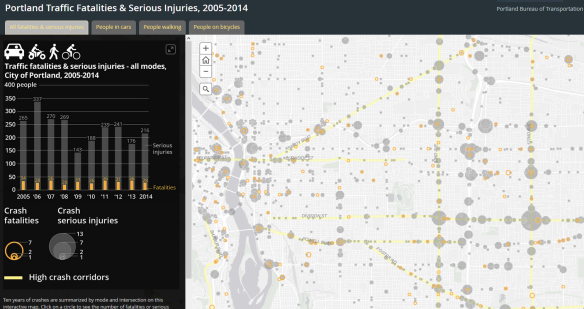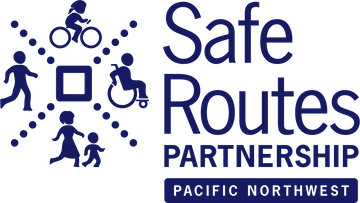Vision Zero shares many goals with Safe Routes to School. Vision Zero originated from Sweden in 1997 with the assertion that all traffic deaths and severe injuries are preventable. Sweden’s Vision Zero work was based on an old philosophy with a new twist: “it should no longer be the child that should adapt to traffic conditions, but the traffic conditions that should be adapted – as far as possible – to children.”
At their core, each one is a comprehensive campaign using a mix of education, improved engineering and targeted enforcement tailored to its specific environment to improve the safety of transportation users. These two efforts share goals and should work in harmony to enhance the safety for transportation users, particularly with one of the more vulnerable demographics – our youth.
Children are considered vulnerable transportation users as they are disproportionately injured or killed in traffic-related crashes:
- Being struck by a vehicle is the leading cause of injury-related deaths for youth under 14[1]
- In 2013, children under 15 accounted for seven percent of bicycle fatalities and 11 percent of injuries[2]
- Youth under 15 accounted for five percent of all pedestrian fatalities and nearly 15 percent of injuries in 2013[3]
The statistics are even worse for disadvantaged communities. Nationally, pedestrian fatality rates in low-income metro areas are almost twice that of more affluent neighborhoods[4]. Safe Routes to School and Vision Zero have important roles in improving these statistics.

As the number of small and large towns and cities pursuing Vision Zero policy grows, it becomes clear that Vision Zero and Safe Routes to School are stronger together. Kari Schlosshauer, PNW Regional Policy Manager, holds a seat on the City of Portland’s Vision Zero Task Force, where she’s been participating in the process to create a set of actions for the city and its partners. The Oregon Safe Routes to School Conferenceheld in June in Eugene, provided insight from Seattle, Portland & Eugene on how Safe Routes to School and Vision Zero efforts are working in tandem to boost successes. Here are some takeaways from the conference, and updates on what’s happening from our perspective on Portland’s Vision Zero Task Force.
Vision Zero and Safe Routes to School both use data to guide implementation
Most safety and Vision Zero initiatives are data-driven to seek those locations with the greatest need for safety improvements based on crash data. Safe Routes to School initiatives seek to make interventions based on data derived from the school populations’ current travel habits, and real and perceived safety barriers and opportunities. Safety can mean prevention of injury in road collisions, but can also encompass safety from violence/crime, as outlined here.
- The City of Portland’s High Crash Network (HCN) includes 30 roadways; a composite of the top 20 high crash roads for driving, the top 20 for bicycling, and the top 20 for walking. Students from more than a third of the elementary schools in Portland Public, David Douglas, Centennial, Reynolds & Parkrose School Districts, must cross or travel along one of these roadways to get to their school.

Safe Routes to School and Vision Zero are both partnering-based
The purest intent of Safe Routes to School initiatives is to draw together diverse constituencies to work together to address the challenges and opportunities for increasing active travel to and from schools. By drawing together stakeholders from transportation, health, education, and other areas, plus diverse community representatives, many Safe Routes to School initiatives have successfully improved the infrastructure near schools, and provided support for increased numbers of students walking and rolling. Those changes have led to an increase in children walking and bicycling safely on a regular basis.
Vision Zero is designed to also work from a collaborative process among diverse stakeholders. It is important to include school representatives on Vision Zero efforts, particularly those representing disadvantaged populations in a community. Statistics routinely bear out that crash and injury incidences frequently occur near school zones, particularly in disadvantaged communities, so these populations need to be included in Vision Zero decision-making processes.
- Portland’s Vision Zero Task Force includes these partners, and regularly seeks to reach and include more perspectives from the community.
Safe Routes to School projects increase safety for everyone at all times of day, therefore are essential to Vision Zero’s goals
Low-income or disadvantaged communities often have inadequate or non-existent infrastructure to ensure the safe travel of pedestrians and bicyclists, while more people in these communities routinely walk or bicycle for transportation. As a result, injury and fatality rates tend to be higher in disadvantaged communities. Safe Routes to School initiatives have increasingly worked to address and reverse disparities in these communities, and the most successful Vision Zero efforts give particular attention to these unique needs in their lower-income neighborhoods.
- A number of items from the City of Portland’s Vision Zero Action Plan include prioritizing capital improvements on the HCN in Communities of Concern. These improvements, when implemented, will benefit students who travel along or across these dangerous roadways.

Vision Zero tackles unsafe streets that have become barriers to kids walking and rolling, therefore are essential to Safe Routes to School’s success
As it began, success with Vision Zero came from an acknowledgement that the road system was failing the user, and many places have focused on engineering.
- The City of Portland’s Vision Zero Actions around engineering improvements include developing citywide standards for pedestrian and bicycle ways and crossings, and securing safety funding to implement them; when implemented, these actions will benefit students’ ability to safely travel to and from school on foot.
Safe Routes to School can expand programming through Vision Zero, to reach middle and high school students with traffic safety education
Education of all transportation users is crucial for the success of both Vision Zero and Safe Routes to School. By modifying behaviors while driving, walking, or bicycling, we can improve our safety as well as the safety of others. Several cities, including Seattle and Washington, DC, have incorporated city-wide traffic safety education that will reach all students in all schools, instilling good traffic safety habits at an early age.
- The City of Portland’s action to “develop targeted efforts to engage middle and high school students in traffic safety through the Safe Routes to School program” is warmly welcomed. We are actively encouraging the city to expand this opportunity to reach all youth in Portland schools through traffic safety education that reaches all students in all schools, beginning with the most fundamental right: knowledge and skills focused on walking and walkability.
“Safe streets” resonates in smaller and rural communities
Around 15 percent of Americans, more than 46 million, live in nonmetropolitan regions, which make up 72 percent of US land. Concepts of walkability and neighborhood apply in rural areas, too, but residents may define some characteristics differently. Safe Routes to School initiatives and goals for zero deaths or serious injuries on rural roadways are not only desired, but possible, and may come under a different name.Read the Safe Routes Partnership’s round up of how to address active transportation needs in rural communities.
Vision Zero is a broad-spectrum, targeted campaign that has the ability to dramatically improve the health and safety of all transportation users. The connections and overlap with Safe Routes to School efforts are significant, and the two efforts should be complementary in communities, as children are among the most vulnerable transportation users, particularly in disadvantaged communities. It is imperative that both Vision Zero and Safe Routes to School be implemented in ways that ensure that everyone can travel safely through their community.


